
Burhanpur is a historical city in the Indian state of Madhya Pradesh. It is the administrative seat of Burhanpur District. It is situated on the north bank of the Tapti River and 512 kilometres (318 mi) northeast of city of Mumbai, 340 kilometres (211 mi) southwest of the state's capital city of Bhopal. The city is a Municipal Corporation.

The Masjid-i-Jehan-Numa, commonly known as the Jama Masjid of Delhi, is one of the largest mosques in India.

The Katra Masjid is a former caravanserai, mosque and the tomb of Nawab Murshid Quli Khan. It was built between 1723 and 1724. It is one of the largest caravanserais in the Indian subcontinent. It was built during the 18th century, when the early modern Bengal Subah was a major hub of trade in Eurasia. The Katra Masjid is located in the north eastern side of the city of Murshidabad, in the Indian state of West Bengal. The most striking feature of the structure are the two large corner towers having loopholes for musketry.

The Jama Masjid, also known as Jumah Mosque or Jami' Masjid, is a Friday mosque, located in Ahmedabad, in the state of Gujarat, India. It was built in 1424 during the reign of Ahmad Shah I. The inscription on the central mihrab commemorates the inauguration of the mosque in AH 827 (1423/1424 CE), on the 1st Sarar, or January 4, by Sultan Ahmad Shah I. The mosque lies in the old walled city, and it is situated outside Bhadra Fort area. The old walled city is divided into separate quarters or pols, and the Jami' Masjid is found on the Gandhi Road. Along the south side of the road, the mosque is a short distance beyond the Teen Darwaza or Tripolia Gate. The structure is a Monument of National Importance.
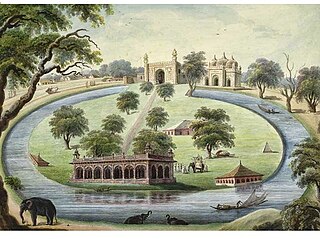
Motijhil, also known as Company's Lake due to its association with the East India Company, is a horse-shoe shaped lake in Murshidabad, West Bengal, India. It was created by Nawazish Muhammad Khan, the son-in-law of Nawab Alivardi Khan. He also constructed a precious palatial palace beside this lake which is called the Sang-i-Dalan which is also known as the Motijhil Palace. It is located at the bend of this lake. It was used as the residence of Nawazish and Ghaseti Begum, Nawazish's beloved wife. It is said that after Nawazish died, Ghaseti Begum lived here until Nawab Siraj ud-Daulah took over the palace and seized the residents' in 1756 AD. With this money he built a similar lake with a beautiful palace, Hirajheel, on the opposite side of the Hooghly River. The palace has a lofty gateway, a mosque known as the "Shahamat Jang" and the Kala Masjid and some other buildings which were all built by Nawazish. This palace was built in 1740. As far as etymology is concerned, the palace has been named so as it was built using black basalt pillars which were brought from the ruins of Gaur. Thus, it was given the name of Sang-i-Dalan or the Stone Palace. This palace was then decorated with different varieties of flower plants and precious marbles.
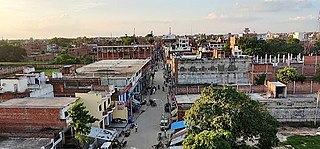
Dildarnagar Kamsar or Kamsaar is a Pargana or a region and a Mashra of 34 places around Karamnasa river in Ghazipur district, and Kaimur District of Uttar Pradesh, & Bihar, India. Of whom main mouzas being 19. It is a large settlement of Khanzada, known as Kamsari Pathans and Afghan Pathans. The original name of the settlement is Kamsaar but because of good and old relations with family of Bara and Bara pathans, the place is called Kamsar-O-Bar.
Amir Chak is a village in Kamsaar in the Indian state of Uttar Pradesh.

Saraila is a village in Kamsaar in the Indian state of Uttar Pradesh.Saraila is a village in Seorai Tehsil in Ghazipur District of Uttar Pradesh, India. It belongs to Varanasi Division. It is located 30 km to the south of District headquarters Ghazipur. 11 km from Seorai. 372 km from State capital Lucknow. The village was also a part of Daudpur Estate which had its capital at Dewaitha during Mughal and early British era.
Mania is a village in Kamsaar in the Indian state of Uttar Pradesh. It is located in Seorai Tehsil in the Ghazipur district. It is situated 22 km (14 mi) from the sub-district headquarters Seorai and from the district headquarters Ghazipur. Its total area is 428.68 hectares and a total population of 5736. Mania village was established in the early 1590 a.d. by Khizir Khan, who was a grandson of Narhar Khan.
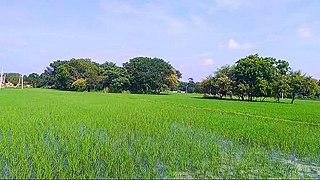
Chitarkoni is a village in Kamsaar in the Indian state of Uttar Pradesh.

Jaburna is a village in Kamsaar in the Indian state of Uttar Pradesh.

Rajgan Mosque is a historic mosque located in Khanpur, Khyber Pakhtunkhwa, Pakistan. It is located at the northern edge of the Khanpur Dam reservoir. It is locally known as ‘Rajon ki Masjid’, and is usually deserted except for Eid congregations. It is a 90-minute drive away from Islamabad.
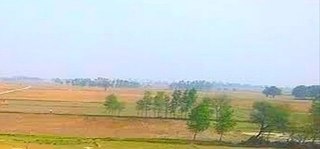
Rasulpur newada is a village of Kamsaar in Ghazipur district, Uttar Pradesh, India. As of 2011 census the main population of Rasulpur lived in an area of 7.5 acres.
Seorai is a village of Dildarnagar Kamsar, and also serve as the headquarters of SeoraiTahsil in region of Ghazipur District of Uttar Pradesh, India. The Seorai tehsil was made a tehsil of the Ghazipur District in year 2016. It consists of 142 villages and one town. Seorai main village has a total area of 878.02 hectares and a population of 20000 but its total area is 1,082.83 hectares and a population of 20,530 which also includes Bhadaura. Seorai tehsil has the total area of 366.62 km2 (141.55 sq mi). Seorai also served as the capital of Kamsaar estate from late 1500s to mid 1600s.
Nawali is a village in Seorai tehsil of Ghazipur District, Uttar Pradesh, India.
Jalalabad is a large village in Jakhania tehsil located in Ghazipur District of Uttar Pradesh India.

Dildarnagar is a municipality in Kamsaar of Ghazipur District, Uttar Pradesh, India. Dildarnagar is a fast-developing town. It is located 34 km from Ghazipur. It is also known as the heart of the Kamsaar-o-Bar region. The total area of Dildarnagar includes Fatehpur Bazar, Dildarnagar Gao, Tajpur, and Nirahukapura. These four neighbourhoods form the town of Dildarnagar. As of the 2011 census, the population of Dildarnagar was 28,913 and the town had an area of 1,995.95 hectares. Dildarnagar is on the road from Varanasi to Buxar. It was also the capital of Dildarnagar Estate.

Dewaitha is a village of Dildarnagar Kamsar,in Zamania tehsil of Ghazipur, India, located on the banks of the Karmanasa River and it's tributary Eknaiya, The village had a population of 7,104 as of the 2011 Census of India. The place is inhabited by Kamsar Pathans..

Jama Masjid is a congregational mosque located at Motijhil, in the historic city of Murshidabad, West Bengal, India.
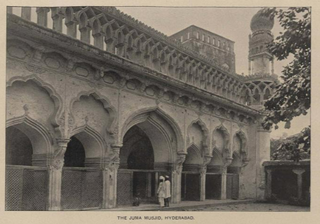
The Jama Masjid is a mosque located in Hyderabad, in the Indian state of Telangana. It is situated to the northeast of the Charminar at a short distance, approached by a narrow lane. It was built in 1597–98, around the same time as the founding of Hyderabad, and was one of the first mosques to be built in the city.














